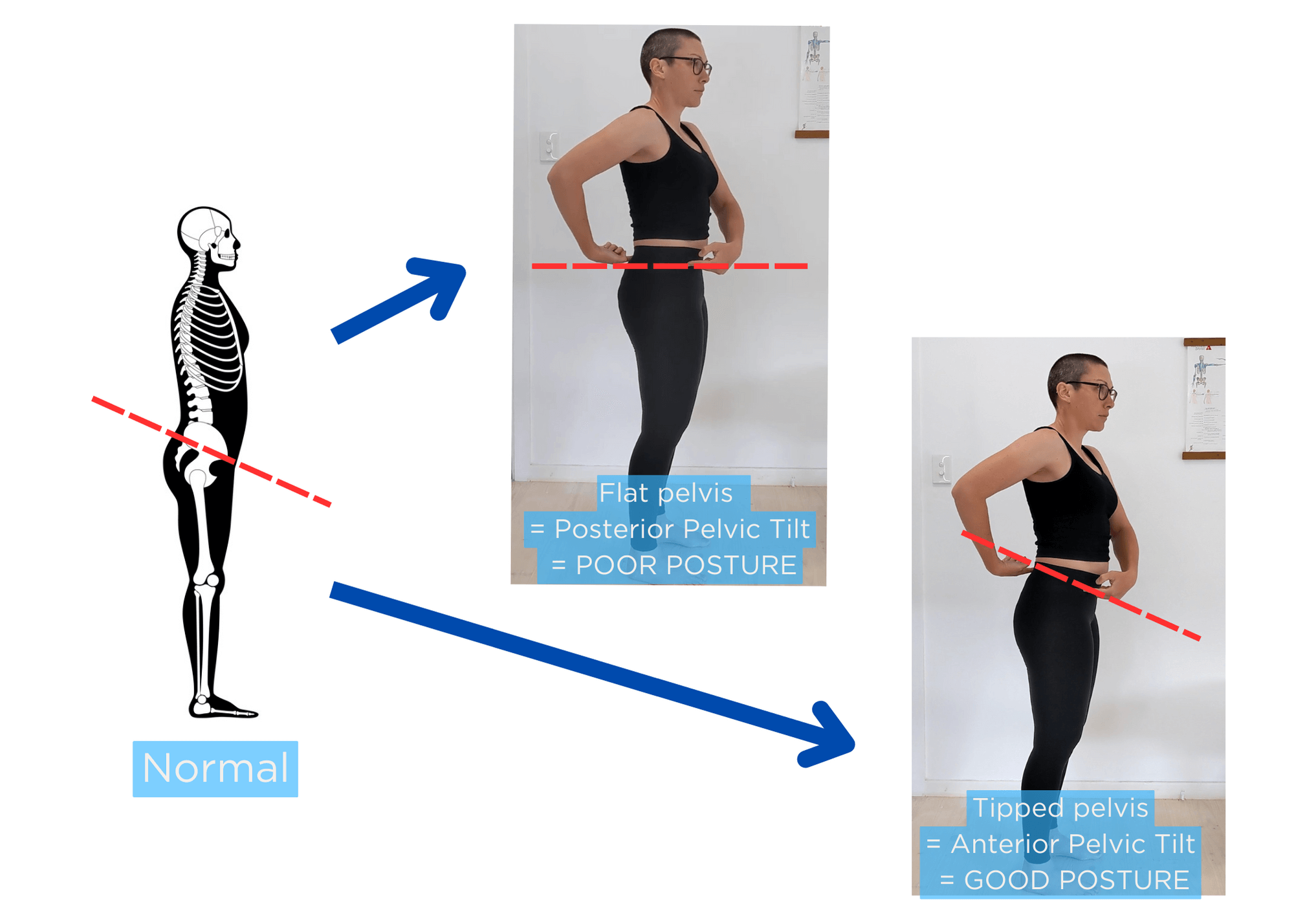Is Your Anterior Pelvic Tilt Causing You Pain? Here’s What You Need To Know.
Pelvic Tilt Definition: What Is Pelvic Tilt?
Pelvic tilt is the way we describe the resting posture of the pelvis, and corrective exercises to “fix” anterior pelvic tilt are one of the biggest causes of injury we see. Yep, you read that right, people trying to “fix” anterior pelvic tilt cause more injuries than they solve. This is usually because they don’t have a good understanding of what position their pelvis should be in to start with, so they end up trying to “fix” it into the wrong position causing themselves more pain and problems in the process.
So, What Is Good Pelvic Tilt?
There are a number of ways to measure pelvic tilt. The easiest is to draw a line between the bony bit at the front of the hip (ASIS) and the dimple at the back of the sacrum (PSIS). When this line angles down at the front, the pelvis is in anterior pelvic tilt. When the line angles down at the back, the pelvis is in posterior pelvic. But what is ideal?
The assumption that many people make (including many health and fitness professionals) is that the ideal, or neutral position of the pelvis is when this line is horizontal. It makes nice artistic sense right? A line parallel to the ground looks good on paper, but this is where the problem lies, because the assumption that the ideal position of the pelvis is when this line is horizontal is not grounded in any kind of science or fact.
In fact, what the studies do tell us is that in asymptomatic populations (people without pain) the majority of people rest in a position where the line of pelvic tilt is tipped forward (anterior pelvic tilt!), with “normal” being anywhere from 13-20 degrees of tilt. The studies also tell us that in athletic populations, anterior pelvic tilt contributes to greater speed, jumping ability, lifting ability and fewer injuries.
So, what we should all be striving for, the ideal pelvis position that reduces pain and improves performance is actually anterior pelvic tilt which is exactly why trying to “fix” your anterior pelvic tilt is more likely to cause you pain than solve it.
What Causes Bad Pelvic Tilt?
The idea that anterior pelvic tilt is good and ideal is pretty challenging to a lot of our patients when we first explain it to them, and we can’t blame them for that. In our Western culture, we’ve all been exposed to thousands of messages to get us to “tuck the tailbone”, “flatten the back” and “suck in the belly”. Or parents, teachers, coaches (and even physios back-in-the-day before we wised-up) have been perpetuating this misinformation.If you think about it right now you can probably remember a number of times off the top of your head when you’ve been at the gym, at a dance class or in a training session and someone has told you to “squeeze your glutes” or “brace your belly” Just because it’s the most common thing you hear doesn't’ mean it is the most correct however, especially not in this day when anyone and everyone can get their two cents out on the world wide web.
This woman is incorrectly gripping her belly (abdominal muscles) in this exercise, which is creating this flat back position (posterior pelvic tilt) commonly associated with back pain and tight hip flexors.
This man is gripping/ squeezing his bum muscles and pulling his pelvis into posterior pelvic tilt (he consequently has “no bum” as his glute muscles are underdeveloped).
So, what makes this blog and our opinion any different? Well, first of all, we know that we see this all day, every day. We see the people who walk in, in pain, who have spent their lives tucking their hips under and flattening their backs, but who can walk out 45 minutes later without pain after we teach them a true neutral (i.e. anteriorly tilted) pelvis.
We also know that bum muscles and belly muscles aren’t designed for controlling posture over a sustained period, they are big and strong and designed to create a movement, then turn off. This is why keeping them turned on 24/7 to try to use them to control your posture is never going to work, it’s not their job and it’s the equivalent of getting a plumber to connect the electrics in your new house
Finally, we have a bulletproof way of identifying each and every individual's true neutral pelvis. Our speciality is whole-body physiotherapy and understanding the relationships between all the different parts of the body to optimise your whole musculoskeletal system. This means we don’t just aim for an arbitrary degree of tilt that the research tells us is in within the normal range, we determine your exact neutral pelvic tilt by feeling the effect on the alignment of your ribcage, the joints of your lumbar spine, your hips and the function of your core. When your pelvis is in neutral, all of these surrounding areas and muscles can load and activate the way they’re supposed to, which is also why knowing and living in your neutral pelvic can have such a pain relieving effect on your whole body.
So, if you have question about your pelvic tilt, are suffering from chronic pain or injury, or are simply blown away by the idea that you shouldn’t be flattening your back and sucking in your tummy in day-to-day-life, make an appointment. Let us help you figure out exactly where you should be and how to live like that. Move Well, Move Mountains.




